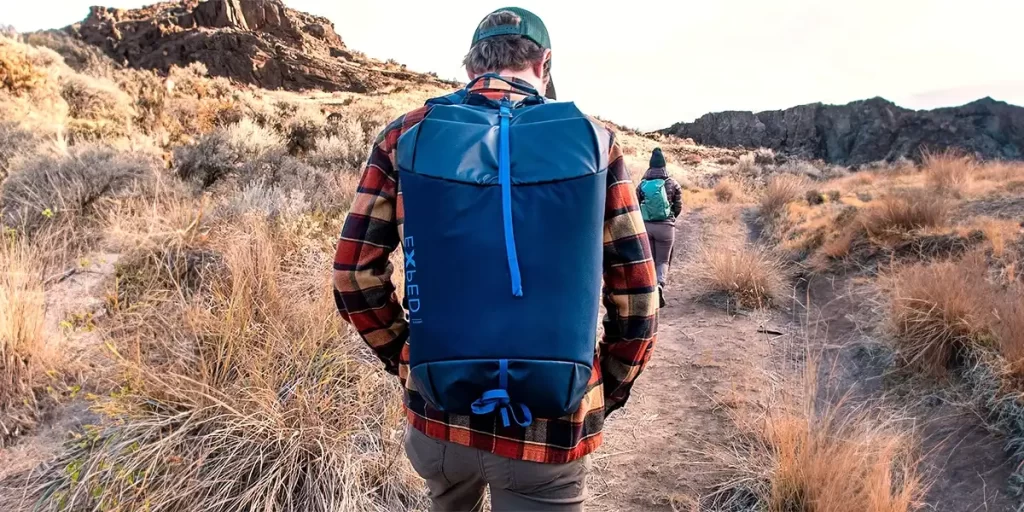

Unexpected rain or crossing a river can soak your gear, turning your outdoor escape into a wet challenge. That’s where the right gear, especially a good backpack, comes in handy.
In this post, we’ll delve into the realm of waterproof backpacks (sometimes referred to as dry packs). We’ll explore their significance, types, materials, and more.
Interested? Let’s get started.
Waterproof backpacks act as shields for your belongings, ensuring they stay dry even when you’re immersed in water during activities like river trail trekking. These backpacks are crucial for keeping your gear dry, which is essential for safety in such environments.
To make an informed choice, it’s crucial to understand two key aspects of waterproof backpacks: the material they’re made of and their waterproof ratings, which we’ll explore in the following discussion.
When it comes to waterproof hiking backpacks, the right materials can be the difference between a soggy adventure and a dry, comfortable one. Here are some of the materials you’ll want to see:
When it comes to choosing a waterproof hiking backpack, you’ll often come across something called “waterproof ratings.”
These ratings are like the backpack’s secret code, telling you how well it can keep your gear dry. Let’s decode this important aspect.
Waterproof ratings are typically expressed in the form of “IPX” followed by a number. Here’s what it means:
| IPX 0 | No protection |
| IPX 1 | Protected against condensation or dripping water falling vertically |
| IPX 2 | Protected against spraying water when tilted up 15 degrees vertically |
| IPX 3 | Protected against spraying water when tilted up to 60 degrees vertically |
| IPX 4 | Protected against splashing water from any angle |
| IPX 5 | Protected against splashing water from any angle |
| IPX 6 | Protected against low pressure water stream for any angle |
| IPX 7 | Protected against water immersion for 30 minutes at a depth of 3.28 ft (1m) |
| IPX 8 | Protected against continual water submersion in under water conditions |
So if you’re expecting heavy rain or plan to be near water, you’ll want a backpack with a higher IPX rating to ensure your gear stays dry.
What makes a hiking backpack genuinely waterproof to earn a higher IPX rating? It’s all about the features that protect against the elements and ensure your gear stays dry.
Let’s explore these key features:
These features work together to make your backpack a reliable guardian against rain, snow, and wet conditions.

Now that you are an expert in the basics. Let’s talk about how to choose the perfect waterproof hiking backpack for your outdoor adventures. There are several key factors to consider:
By considering these factors, you can choose a waterproof hiking backpack that matches your needs and preferences. Don’t know where to start? You can check out waterproof backpacks from Exped, Sea to Summit or Osprey.
In this post, we’ve explored waterproof hiking backpacks (also reffered as dry packs), their significance, types, materials, and waterproof ratings. Now, you’re equipped to choose the perfect waterproof backpack for your adventures, rain or shine.
Remember, these backpacks are about safety and comfort. So, pick the one that suits your needs, and venture into the wilderness confidently, knowing your gear will stay dry.
Waterproof backpacks offer a high level of water resistance, but their true waterproofness depends on various factors like construction, materials, and design. To ensure your gear stays dry, select a backpack with features such as sealed zippers, welded seams, and waterproof fabrics. For added protection, consider using waterproof liners or dry bags for valuable items. Understanding your backpack’s waterproof features and using it correctly can help prevent water infiltration during outdoor activities.
Are waterproof backpacks worth it? It depends on your outdoor activities. For adventures in wet conditions like hiking or kayaking, they offer valuable gear protection. However, if you’re mostly indoors or in dry settings, a standard backpack may suffice. Your decision should align with your specific needs and the level of gear protection required for your outdoor pursuits.